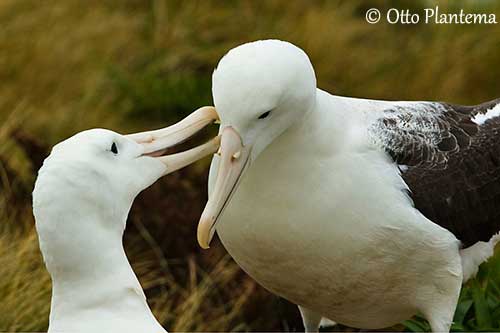
Fr: Albatros royal du Sud – Albatros royal
Ang: Southern Royal Albatross
All: Südkönigsalbatros
Esp: Albatros real meridional
Ita: Albatro reale
Nd: Zuidelijke Koningsalbatros
Sd: sydlig kungsalbatross
Photographers:
Otto Plantema
Trips around the world
Simon Tan
PBase Bird galleries
Text by Nicole Bouglouan
Sources :
HANDBOOK OF THE BIRDS OF THE WORLD vol 1 by Josep del Hoyo-Andrew Elliot-Jordi Sargatal - Lynx Edicions - ISBN: 8487334105
A Complete Guide to Antarctic Wildlife by Hadoram Shirihai and Illustrated by Brett Jarrett - Edited by Guy M. Kirwan - ALUL.A Press Oy, Finland - ISBN 9519894705
Wikipedia, the free encyclopaedia
Te Ara – The Encyclopedia of New Zealand
New Zealand bird status between 2008 and 2012
Animal Diversity Web (University of Michigan Museum of Zoology)
New Zealand birds and birding (Narena Olliver)
Department of Sustainability, Environment, Water, Population and Communities
Te Ara – The Encyclopedia of New Zealand
Southern Royal Albatross
Diomedea emophora
Procellariiformes Order – Diomedeidae Family
INTRODUCTION:
The Southern Royal Albatross is one of the largest albatrosses of the family Diomedeidae with a wingspan of up to 350 cm. It is included in the genus Diomedea which gathers the largest albatrosses.
Like numerous seabirds, the Southern Royal Albatross is threatened by longliners and trawlers in Pacific, Indian and Atlantic Oceans.
This species breeds on just four predator-free islands. They are nature reserves, now declared a World Heritage Site. However, the Dracophyllum scrub is spreading on Campbell and Enderby Islands, reducing the areas of suitable nesting habitat.
The population appears to be recovering and even increasing, but the species is currently considered as Vulnerable.

DESCRIPTION OF THE BIRD:
Biometrics:
Length: 107-122 cm
Wingspan: 290-350 cm
Weight: M: 8100-10,300 g – F: 6500-9000 g
The adult has white plumage overall, except the flight-feathers and a variable amount of wing-coverts which are blackish. The tail is white, sometimes with some blackish on sides and tips.
The underwing is white except the black flight-feathers and some coverts on the carpal area. We can see a narrow, black trailing edge.
The old birds are usually whiter with some brown and grey vermiculations on neck, breast and flanks.
The bill is pale pinkish with creamy to horn-coloured tip, and black cutting edge to the upper mandible. The eyes are dark brown. Legs and webbed feet are pale pink or pale greyish-blue.
Male and female have similar plumage, but the male is larger overall.
The juvenile resembles adults but it has blacker wings and black flecking on back, flanks, crown and tail.
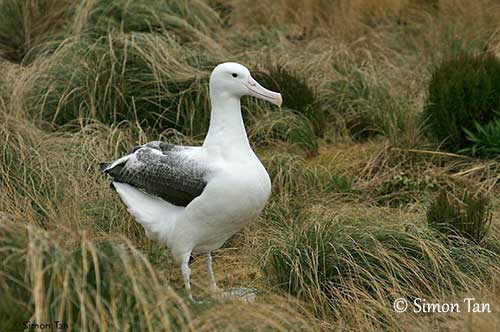
RANGE:
The Southern Royal Albatross breeds mainly on Campbell Island, with a smaller proportion on Enderby, Adams and Auckland Islands.
The foraging areas extend from continental shelf and inner slope of southern New Zealand and Campbell plateau, to S Chile, Uruguay and Argentina.
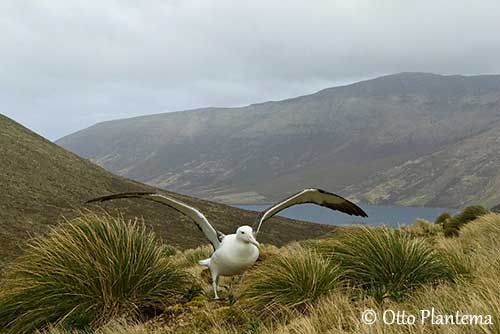
HABITAT:
The Southern Royal Albatross nests on small remote islands, on grassy slopes where the tussock grass Poa litorosa provides them a shelter for their nests. However, it often establishes the nest-site in more open areas to facilitate both landing and take-off.
On Campbell Island where about 99% of the population is nesting, the Southern Royal Albatross nests at mid-elevation, between 180 and 350 metres, usually among tussock grasslands and megaherb fields.
Outside the breeding season, they are marine and spend most of the time at sea.
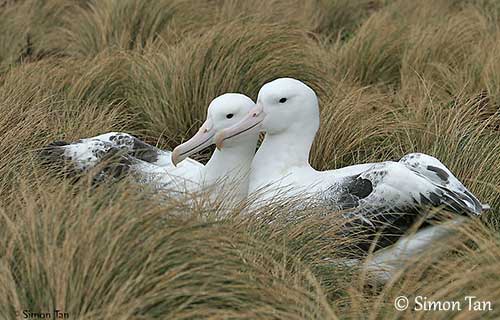
CALLS AND SONGS: SOUNDS BY XENO-CANTO
The Southern Royal Albatross gives high-pitched screaming bray during displays and croaking, yapping and clucking calls too.
BEHAVIOUR IN THE WILD:
The Southern Royal Albatross feeds primarily on several species of cephalopods including squid and pelagic octopuses, but it also takes fish and some crustaceans.
The preys are caught mainly by surface-seizing. However, this bird may perform shallow plunges beneath the surface.
It feeds on squid at night, when they come to the surface. The Southern Royal Albatross is not very gregarious with other albatrosses, but they gather sometimes around abundant food sources. It often feeds with other Procellariforms.
It also takes offal while attending trawlers, but it rarely follows the ships.
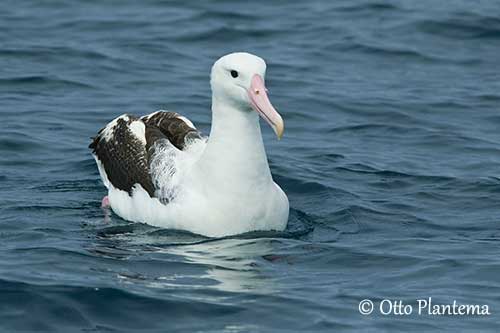
The Southern Royal Albatross is usually solitary at sea, but on the breeding grounds, several displays are observed. The birds adopt a variety of postures accompanied by calls. The courtship displays include bill-snapping (often aggressive), clapping and gulping. Other displays by pairs include sky-calling with outstretched wings, and neck and head stretched upwards, bill-circling, sky-pointing, and flank-touching with the bill, always accompanied by calls. At nest, both adults perform mutual preening.
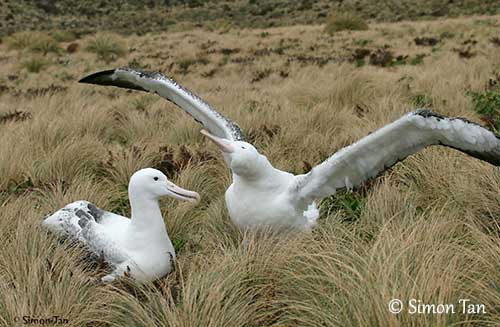
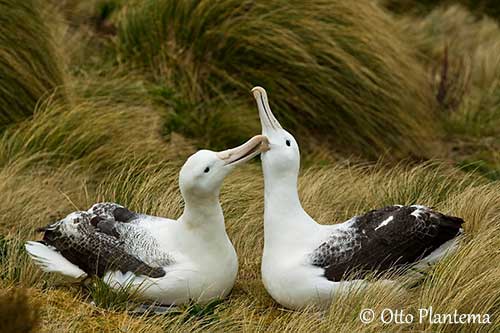
The Southern Royal Albatrosses are monogamous with long-term pair-bonds. They breed in loose colonies with scattered pairs, and their breeding pattern is biennial.
The young birds gather to display on the breeding grounds in gams. Gaming and pair displays are similar.
After breeding, the Southern Royal Albatross disperses widely over the Southern Ocean, but it usually avoids the Antarctic seas, preferring slightly warmer waters between 6 and 20°C of surface temperatures.
The foraging trips during the incubation range between 2900 and 6600 kilometres. The post-breeding movements are probably East in circumpolar movement. They reach the coasts of South America off Chile, and SW Atlantic off Patagonia. They can be seen too off South Africa, Australia and Tasmania.
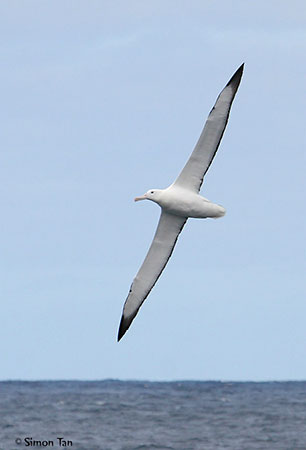
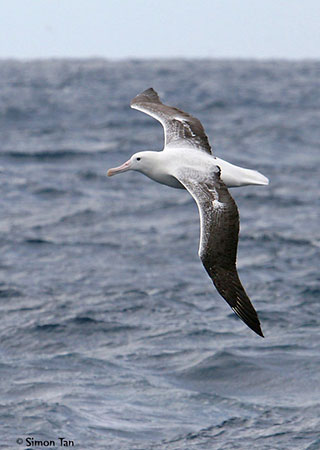
The Southern Royal Albatross is spectacular in flight, a graceful bird with large wingspan. It is able to travel long distances, mainly by gliding and sailing on the wind. Above the ocean, it flies into the wind to gain elevation before to turn back towards the sea to gain speed. However, take-off and landing are anything but graceful.
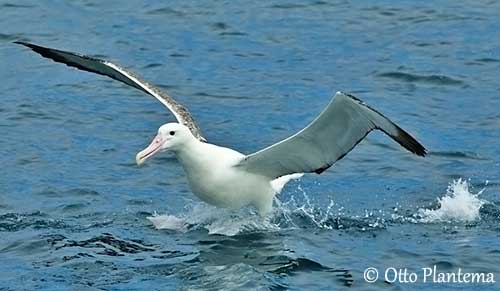
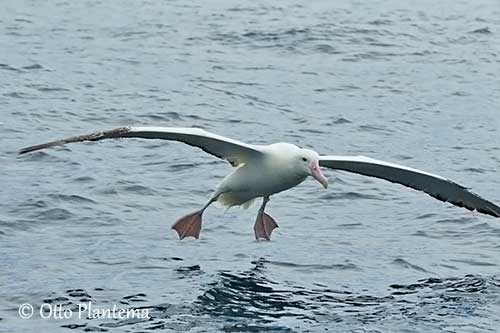
REPRODUCTION OF THIS SPECIES:
The breeding season starts in October, with the egg-laying in late November/December.
The Southern Royal Albatross nests in scattered groups of few pairs on grassy slopes and exposed sites such as ridges and peat bogs for better take-off and landing.
The nest is a truncated cone on the ground made with mud and vegetation including moss, grass and ferns.
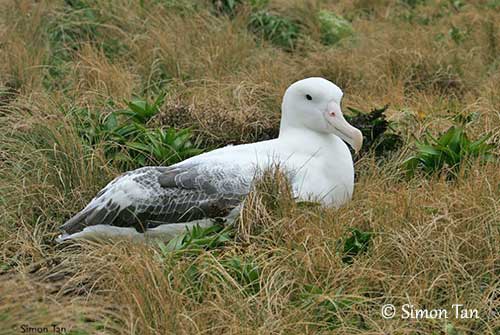
The female lays a single white egg with some reddish spots. Both adults incubate during 74-85 days (79) with stints of 2-3 weeks. At hatching, the chick has white down. It is brooded and guarded by an adult during 35-40 days. It fledges 240 days after hatching.
The breeding cycle of this species is usually biennial with some exceptions.
The juvenile does not return to its natal colony until 4-8 years of age, and it breeds at 9-11 years old.
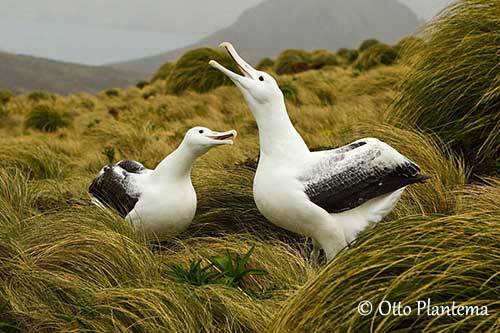
PROTECTION / THREATS / STATUS:
The Southern Royal Albatross is slightly recovering, following important decline in past. The global population is estimated to number 27,200 mature individuals, with 7800 pairs on Campbell Island (1996 and 2004/2008), 70 pairs on Enderby (2003) and 20 pairs on Auckland and Adams Islands (1998). The population appears stable and possibly increasing.
The main threat is from longliners and trawlers in Pacific, Indian and Atlantic Oceans and off the W coasts of South America.
The Southern Royal Albatross is currently classified as Vulnerable.